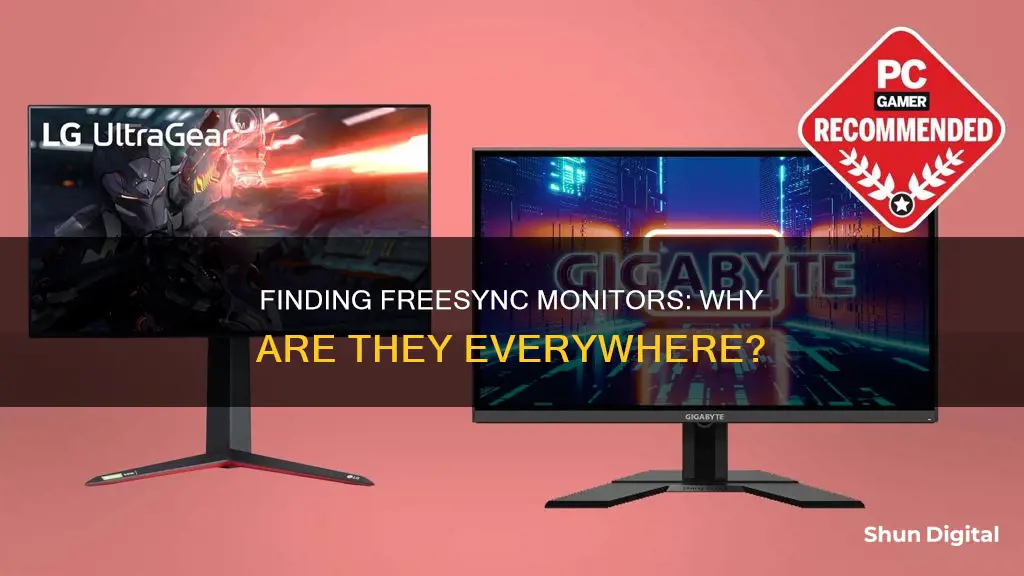
FreeSync is an adaptive synchronization technology for LCD and OLED displays that support a variable refresh rate. It was developed by AMD and first announced in 2014 to compete against Nvidia's G-Sync. FreeSync dynamically adapts the display refresh rate to variable frame rates, which helps remove stuttering delays and screen tearing. FreeSync is not limited to AMD graphics cards and is also compatible with select Nvidia graphics cards and select consoles. FreeSync has been split into three tiers: AMD FreeSync, AMD FreeSync Premium, and AMD FreeSync Premium Pro, each with additional features.
What You'll Learn

FreeSync vs G-Sync
FreeSync and G-Sync are adaptive sync technologies that aim to solve the issue of screen tearing by syncing the monitor's refresh cycle with the rate at which the connected PC's graphics card renders each frame of video. Screen tearing is a problem that occurs when the refresh rate of your monitor is not synchronized with the frame rate of the game you're playing, resulting in visual oddities like the top half of your screen showing a slightly different image from the bottom half.
G-Sync is developed by Nvidia and FreeSync is developed by AMD. G-Sync monitors generally carry a price premium because they require a specific hardware module from Nvidia to be installed, whereas FreeSync works natively over DisplayPort 1.2 and newer without any additional hardware costs. This means that for FreeSync, your GPU needs to have a DP 1.2 or newer output, and you need to use a DP 1.2 or newer cable. FreeSync monitors can also be certified as G-Sync Compatible, which means they can run G-Sync within Nvidia's parameters despite lacking the proprietary scaler hardware.
In terms of compatibility, G-Sync monitors will work with older GPUs since they have the dedicated hardware module. On the other hand, FreeSync is only compatible with AMD GPUs from the RX 200 series onwards.
When it comes to performance, both technologies produce similar results in terms of eliminating screen tearing and providing maximum performance and minimal latency. However, G-Sync monitors offer a slight advantage in terms of guaranteeing no tearing even at the lowest refresh rates, as they double the frame renders below 30 Hz to keep them in the adaptive refresh range. Additionally, G-Sync monitors offer blur-reduction (ULMB) which may be preferred by some users, although it is not unique to G-Sync as some FreeSync monitors also have it under a different name.
In summary, the choice between G-Sync and FreeSync depends on your GPU and monitor combination, as well as your budget. If you're looking for a more affordable option and don't mind using AMD GPUs, FreeSync is a great choice. If you want the flexibility to use older GPUs and are willing to pay a premium, G-Sync monitors might be a better option. Ultimately, both technologies provide a similar gaming experience, and the decision should be based on your specific needs and preferences.
Troubleshooting Arcade1Up Monitor: Is It Busted?
You may want to see also

FreeSync Standards
FreeSync is an adaptive synchronization technology for LCD and OLED displays that support a variable refresh rate. The technology was developed by AMD and first announced in 2014 to compete with Nvidia's G-Sync. It is royalty-free, free to use, and has no performance penalty.
FreeSync dynamically adapts the display refresh rate to variable frame rates, which helps remove stuttering delays and screen tearing. Transitions between different refresh rates are seamless and undetectable to the user. The sync mechanism keeps the video interface at the established pixel clock rate but dynamically adjusts the vertical blanking interval. The monitor keeps displaying the currently received image until a new frame is presented to the video card's frame buffer, after which the transmission of the new image starts immediately. This mechanism provides low monitor latency and a smooth, virtually stutter-free viewing experience.
FreeSync is based on DisplayPort 1.2a, using an optional feature that VESA terms Adaptive-Sync. It has also been implemented over HDMI 1.2+ as a protocol extension, and HDMI 2.1+ has its own native variable refresh rate system.
AMD has split its FreeSync technology into three tiers: AMD FreeSync, AMD FreeSync Premium, and AMD FreeSync Premium Pro. AMD FreeSync requires the display to pass certification for low latency and refresh rate variation to match the render output of the graphics card. AMD FreeSync Premium mandates further requirements of Low Framerate Compensation (LFC) and at least 120 Hz refresh rate at FHD resolution. AMD FreeSync Premium Pro adds luminance and wide color gamut requirements.
Tucson's Best Places to Sell Your Old Monitors
You may want to see also

FreeSync on Nvidia cards
In 2019, Nvidia announced that it would support FreeSync monitors with GeForce GPUs, meaning that most gaming monitors are now capable of variable refresh rates (VRR) on both GeForce and Radeon graphics cards without any issues.
Nvidia's support for adaptive sync displays is divided into four tiers. The first is G-Sync Ultimate, the new name for G-Sync HDR. These monitors include Nvidia's G-Sync HDR module and support the full suite of HDR features. The second tier is regular G-Sync, which includes the adaptive sync monitors that have always worked with Nvidia GPUs only. The third tier is "G-Sync compatible" monitors, which are FreeSync monitors that Nvidia has certified to pass their strict G-Sync performance metrics. They support the VESA Adaptive Sync standard, so they also work with AMD GPUs.
The fourth tier is the ability to use any FreeSync or VESA Adaptive Sync monitor with an Nvidia GPU via a toggle in the Nvidia Control Panel. Nvidia claims that this tier is for "VRR monitors yet to be validated as G-Sync compatible" and that enabling the feature may work fully, partially, or not at all. However, in reality, every adaptive sync monitor is now supported, and all you need to do is enable the toggle.
To enable adaptive sync support for non-certified monitors, open the Nvidia Control Panel, browse to "set up G-Sync", then select your FreeSync monitor. Make sure both the "enable G-Sync, G-Sync compatible" checkbox and the "enable settings for the selected display model" checkbox are ticked. Then click Apply, and your monitor will restart with adaptive sync enabled.
It's important to note that FreeSync must also be enabled on the monitor itself, usually through the on-screen menu. Additionally, FreeSync on Nvidia GPUs only works through DisplayPort, not HDMI.
Overall, Nvidia's support for FreeSync is a positive development for the industry and consumers, as it brings more affordable adaptive sync monitors to owners of the most popular GPUs on the market.
Connecting Your Xbox to the New MSI Monitor
You may want to see also

FreeSync-compatible GPUs
FreeSync is an adaptive synchronization technology for LCD and OLED displays that dynamically adapts the display refresh rate to variable frame rates. This technology was developed by AMD and first announced in 2014 to compete against Nvidia's G-Sync.
All AMD GPUs starting with the second iteration of Graphics Core Next support FreeSync. Additionally, Nvidia 10-series (Pascal) and newer GPUs with driver version 417.71 or higher also support FreeSync. This means that graphics cards such as the GTX 1080 Ti, as well as any RTX card from the 20 series onwards, are FreeSync-compatible.
To enable FreeSync with an Nvidia graphics card, you will need to ensure that you are using a compatible monitor, connected via DisplayPort 1.2 or later. You will also need to be running Windows 10 or later and update your Nvidia drivers to the latest version. Once this is done, you can check your monitor's native menu system to see if FreeSync has been automatically enabled. If not, you can force the feature by opening the Nvidia Control Panel app, clicking on "Manage 3D settings", and then selecting "G-Sync Compatible" from the "Monitor Technology" drop-down menu.
In summary, FreeSync is supported by a wide range of AMD and Nvidia GPUs, and by following the steps outlined above, you can enable FreeSync on a compatible monitor to enjoy a smooth and responsive gaming experience.
Monitor Data Usage: Simple Tips for Combating Overage
You may want to see also

FreeSync Premium Pro
- A minimum refresh rate of 120Hz at FHD resolution, providing smoother gameplay and reducing screen tearing.
- Low framerate compensation (LFC), which automatically activates if the game's frame rate drops below the monitor's refresh rate, ensuring the display stays within its supported refresh rate range.
- Lower input latency for HDR content by allowing games to tone map directly to the display, reducing the number of intermediate steps.
- Over 400 nits brightness with HDR, enhancing the visual experience.
To utilise FreeSync Premium Pro, users require a FreeSync-certified display, such as a monitor, TV, or laptop, paired with a compatible AMD graphics card or APU. Additionally, the necessary Radeon Software graphics driver must be installed, and FreeSync needs to be enabled through the AMD Radeon Settings software.
Asus Monitor Deals: How Often Do They Occur?
You may want to see also
Frequently asked questions
FreeSync is an adaptive synchronization technology for LCD and OLED displays that support a variable refresh rate. It helps to avoid screen tearing and reduce stuttering by synchronizing the monitor's refresh rate with the framerate from the GPU.
FreeSync dynamically adapts the display refresh rate to variable frame rates, which result from irregular GPU load when rendering complex gaming content. This helps remove stuttering delays and screen tearing, providing a smooth and virtually stutter-free viewing experience.
Both FreeSync and G-Sync are designed to achieve a tearing- and stuttering-free effect. The difference is that FreeSync is developed by AMD and is royalty-free and free to use, while G-Sync is proprietary to Nvidia. To use FreeSync, you need an AMD graphics card or an AMD processor in your game console. G-Sync technology is designed to synchronize a monitor's refresh rate with the framerate of an Nvidia graphics card.
FreeSync is not limited to AMD graphics cards and is also compatible with select Nvidia graphics cards and select consoles. Nvidia 10-series (Pascal) and newer GPUs with driver version 417.71 or higher support FreeSync.







